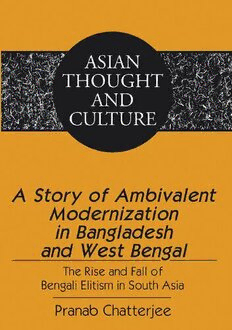Table Of ContentA Story of Ambivalent
Modernization
in Bangladesh
and West Bengal
ASIAN
THOUGHT
AND
CULT URE
Sandra A. Wawrytko
General Editor
Vol. 65
PETER LANG
New York (cid:121) Washington, D.C./Baltimore (cid:121) Bern
Frankfurt am Main (cid:121) Berlin (cid:121) Brussels (cid:121) Vienna (cid:121) Oxford
Pranab Chatterjee
A Story of Ambivalent
Modernization
in Bangladesh
and West Bengal
The Rise and Fall of
Bengali Elitism in South Asia
PETER LANG
New York (cid:121) Washington, D.C./Baltimore (cid:121) Bern
Frankfurt am Main (cid:121) Berlin (cid:121) Brussels (cid:121) Vienna (cid:121) Oxford
Library of Congress Cataloging-in-Publication Data
Chatterjee, Pranab
A story of ambivalent modernization in Bangladesh and West Bengal:
the rise and fall of Bengali elitism in South Asia / Pranab Chatterjee.
p. cm. — (Asian thought and culture; v. 65)
Includes bibliographical references and index.
1. Bangladesh—Civilization. 2. West Bengal (India)—Civilization.
3. Elite (Social science)—Bangladesh. 4. Elite (Social science)—India—
West Bengal. 5. Bengali (South Asian people)—Social conditions. I. Title.
DS485.B493C487 954’.14—dc22 2009026611
ISBN 978-1-4331-0820-4
EISBN 9781453904817
ISSN 0893-6870 (Print edition)
Bibliographic information published by Die Deutsche Nationalbibliothek.
Die Deutsche Nationalbibliothek lists this publication in the “Deutsche
Nationalbibliografie”; detailed bibliographic data is available
on the Internet at http://dnb.d-nb.de/.
The paper in this book meets the guidelines for permanence and durability
of the Committee on Production Guidelines for Book Longevity
of the Council of Library Resources.
© 2010 Peter Lang Publishing, Inc., New York
29 Broadway, 18th floor, New York, NY 10006
www.peterlang.com
All rights reserved.
Reprint or reproduction, even partially, in all forms such as microfilm,
xerography, microfiche, microcard, and offset strictly prohibited.
This book is dedicated to the memory of Uma Chatterjee (1914-1984).
Given in marriage by her father at age 14, she maintained all her life that a
14-year-old is too young and should never be expected to marry. When she
heard that many women were raped during the partition of Bengal in 1947
and that they were not being accepted by their families, she said: “This
(Hindu religion) is a cowards’ religion. It banishes those it cannot protect.”
All her neighbors observed that she was full of “paglami” (madness, dis-
cussed in Chapter 4).
Uma was my mother.
—Pranab Chatterjee
Contents
List of Illustrations………………………………………………………...ix
Preface......................................................................................................... xi
Chapter One ................................................................................................. 1
Introduction: The Ambivalent Modernization of
Bengali Culture
Chapter Two ............................................................................................... 31
Pre-modern Bengal from Antiquity to 1204:
Centuries of Sanskritization - A Culture Built on Fault-lines
Across Caste Divisions
Chapter Three ............................................................................................. 77
Pre-modern Bengal between 1204 and 1757:
Five Plus Centuries of Islamization - Addition of More
Fault-lines Across Religious Divisions
Chapter Four ............................................................................................ 123
Ambivalent Modernization, 1757-1947: Almost Two Centuries of
Anglicization - Conflicts in Knowledge, Identity, and
Loyalty - Addition of More Fault-lines
Chapter Five ............................................................................................. 217
Bangladesh and West Bengal Since 1947:
Ambivalent Modernization Continues - Conflicts between
Islamization, Bengali Nationalism, Marxism, and Peasant
Democracy - Chronologies and Quantitative Trends
Chapter Six ............................................................................................... 245
Bangladesh and West Bengal Since 1947 – Part 2:
Ambivalent Modernization Continues - Conflicts between
Islamization, Bengali Nationalism, Marxism, and Peasant
Democracy - Some Qualitative Trends -
Summary and Conclusions
Appendix ................................................................................................. 279
Intellectual Traditions in Ethnographic Studies
Bibliography ............................................................................................ 283
Index ........................................................................................................ 289
Illustrations
Chronologies
Chronology 2.1: Major Events in Bengal, Before 1204 ............................. 36
Chronology 3.1: Major Events in Bengal, 1204-1757 ............................... 79
Chronology 4.1: Major Events in Bengal, 1757-1947 ............................. 136
Chronology 5.1a: Major Events in Bangladesh Since 1947..................... 223
Chronology 5.1b: Major Events in West Bengal Since 1947 .................. 233
Figures
Figure 1.1: Pathways to Hostage Status ....................................................... 4
Figure 1.2: A Hierarchy of Two Communities before 1204 ...................... 13
Figure 1.3: A Hierarchy of Three Communities, Circa 1536..................... 14
Figure 1.4: A Hierarchy of Four Communities, Circa 1890’s ................... 14
Figure 2.1: Three Stages of Pre-modern Bengal ........................................ 35
Figure 3.1: The Subcultures of Bengal, Circa 1536 ................................... 96
Figure 4.1: A Hierarchy of Four Communities, Circa 1890’s ................. 135
Maps
Map 1.1: Bangladesh and West Bengal in the Early Part of
21st Century ......................................................................................... 17
Map 3.1: The Major Rivers of Bengal ..................................................... 103
Tables
Table 1.1: Fifteen Most Spoken Languages of the World ......................... 11
Table 1.2: Some Basic Information about Bangladesh
and West Bengal .................................................................................. 18
Table 1.3: State Governments in West Bengal and Their
Affiliations, 1947-2006 ........................................................................ 22
Table 3.1: Invasions in Bengal, 1204-1757 ............................................... 84
Table 3.2: A Second (Islamic) Morality Confronts the
First (Hindu) ......................................................................................... 88
Table 3.3: Two Types of Artifacts in the Indian Subcontinent ................ 104
Table 3.4: Some Attributes of “To Do” and “To Be” Cultures................ 105
Table 4.1: Behavioral Styles of the British, 1757-1947 ........................... 147
Table 4.2: Revolts and Revolutions Differentiated .................................. 152
Table 4.3: Behavioral Styles of the Hindu Upper Caste,
1757-1947 .......................................................................................... 165
Table 4.4: Celibacy and Eroticism in Bengali Culture ............................ 179
Pranab Chatterjee - 978-1-4539-0481-7

